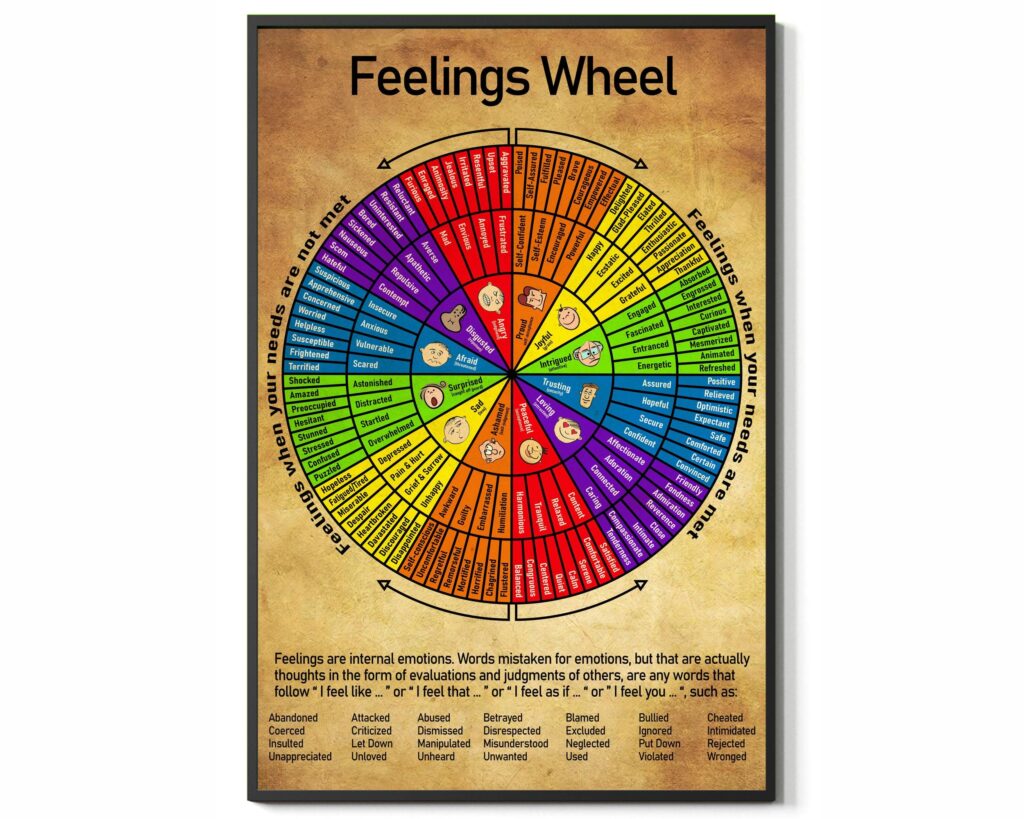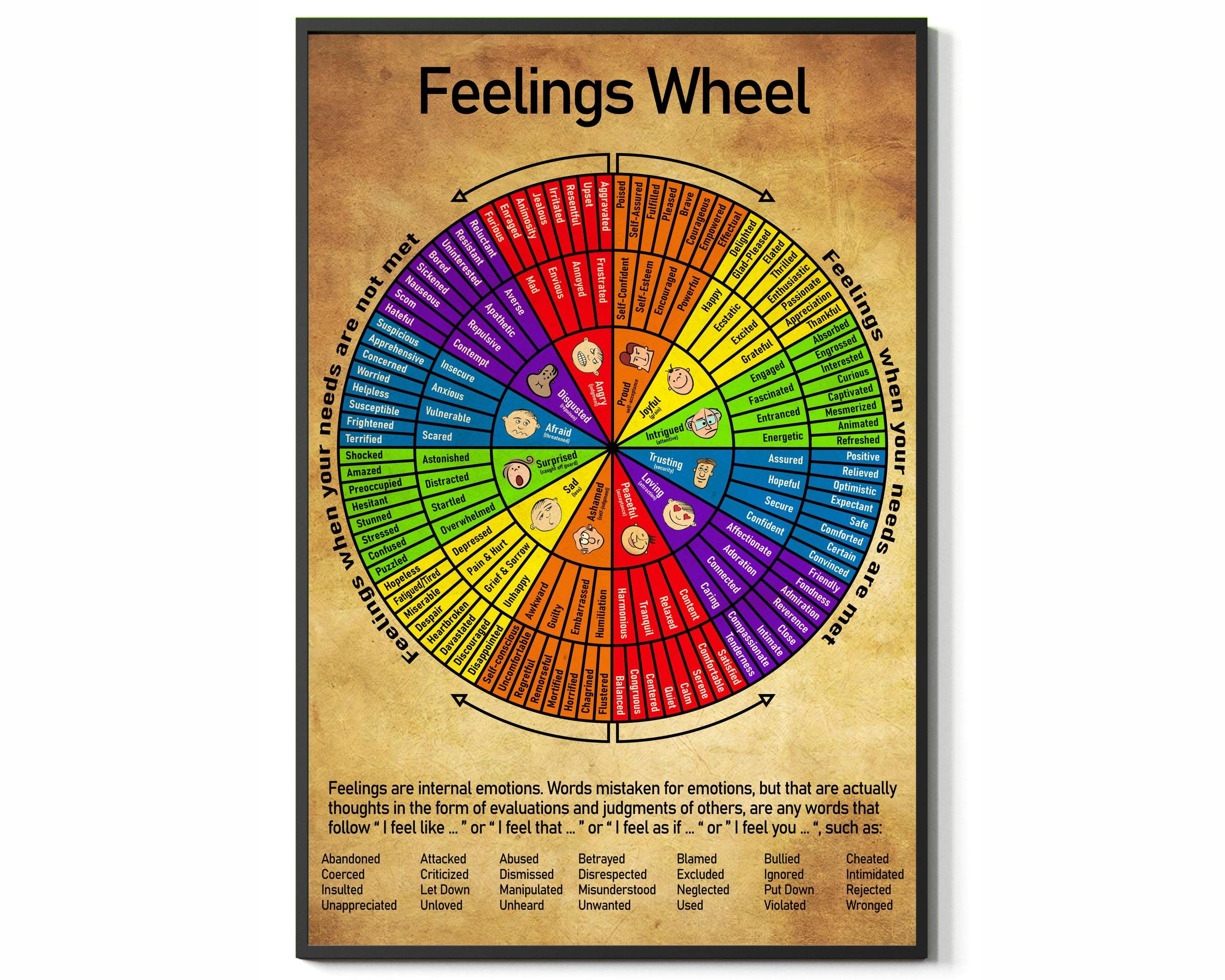
Unlocking Emotional Intelligence: The Emotion Wheel for Adults Explained
In today’s fast-paced world, understanding and managing our emotions is more crucial than ever. Emotional intelligence (EQ), the ability to perceive, understand, manage, and use emotions, significantly impacts our relationships, work performance, and overall well-being. One powerful tool that can help adults navigate the complex landscape of their feelings is the emotion wheel for adults. This comprehensive guide will delve into what an emotion wheel for adults is, how it works, its benefits, and how to effectively use it to enhance your emotional awareness and communication skills.
What is an Emotion Wheel?
An emotion wheel for adults is a visual representation of different emotions, typically arranged in a circular format. Developed by Dr. Gloria Willcox in the 1980s, the wheel usually starts with a core set of emotions in the center, such as happiness, sadness, anger, fear, and surprise. Moving outwards from the center, the wheel branches into more specific and nuanced emotions related to each core feeling. This allows individuals to pinpoint exactly what they are feeling with greater accuracy.
The emotion wheel for adults serves as a valuable resource for individuals who may struggle to articulate their emotions. It provides a structured framework for identifying and labeling feelings, which is the first step toward understanding and managing them effectively. Unlike simpler emotion charts, the wheel offers a wider range of emotional granularity, making it more suitable for adults who experience complex emotional states.
The Structure of an Emotion Wheel
Understanding the structure of an emotion wheel for adults is key to utilizing it effectively. Most emotion wheels are organized into concentric circles, each representing a different level of emotional intensity and specificity. Let’s break down the common layers:
Core Emotions
At the center of the wheel are the primary or core emotions. These are the fundamental feelings that are universally recognized and experienced. Examples include:
- Happiness: Feeling joyful, content, and satisfied.
- Sadness: Experiencing sorrow, grief, or disappointment.
- Anger: Feeling irritated, frustrated, or enraged.
- Fear: Experiencing apprehension, anxiety, or dread.
- Surprise: Feeling astonished, amazed, or shocked.
Secondary Emotions
The next layer of the emotion wheel for adults contains secondary emotions. These are variations or combinations of the core emotions. For instance, under happiness, you might find emotions like “content,” “proud,” and “optimistic.” Under anger, you might find “frustrated,” “irritated,” and “furious.” These secondary emotions provide more specific descriptors, allowing you to better understand the nuances of your feelings.
Tertiary Emotions
The outermost layer of the emotion wheel for adults features tertiary emotions, which are even more refined and specific. These emotions provide the highest level of granularity, helping you to pinpoint the exact feeling you are experiencing. For example, under “frustrated,” you might find “exasperated,” “disappointed,” and “impatient.”
Benefits of Using an Emotion Wheel for Adults
Incorporating an emotion wheel for adults into your daily life can offer a multitude of benefits, contributing to improved emotional intelligence and overall well-being:
Enhanced Emotional Awareness
One of the primary benefits is the development of enhanced emotional awareness. By regularly using the wheel, you become more attuned to your internal emotional landscape. You learn to recognize and label a wider range of emotions, moving beyond simple descriptors like “good” or “bad.” This increased awareness allows you to understand the underlying causes of your feelings and how they impact your behavior.
Improved Communication
The emotion wheel for adults can significantly improve your communication skills. When you can accurately identify and articulate your emotions, you are better equipped to express yourself to others. This leads to clearer and more effective communication, reducing misunderstandings and conflicts. For example, instead of saying “I’m upset,” you might say “I’m feeling frustrated and disappointed because…” This level of specificity helps others understand your perspective and respond appropriately.
Better Emotional Regulation
Understanding your emotions is the first step toward regulating them effectively. The emotion wheel for adults provides a framework for identifying triggers and patterns in your emotional responses. By recognizing these patterns, you can develop strategies to manage your emotions in a healthy and constructive way. For instance, if you notice that you consistently feel anxious in certain situations, you can implement coping mechanisms like deep breathing exercises or mindfulness techniques to calm yourself down.
Strengthened Relationships
Emotional intelligence is a cornerstone of healthy relationships. By using the emotion wheel for adults to understand your own emotions, you also become more empathetic and understanding of others’ feelings. This fosters stronger connections and deeper intimacy in your relationships. When you can validate and respond to the emotions of your loved ones, you create a safe and supportive environment where they feel heard and understood.
Reduced Stress and Anxiety
Suppressing or ignoring emotions can lead to increased stress and anxiety. The emotion wheel for adults encourages you to acknowledge and process your feelings, rather than bottling them up. This can help to alleviate stress and promote emotional well-being. By understanding the root causes of your anxiety, you can address them directly and develop healthier coping strategies.
How to Use an Emotion Wheel Effectively
To maximize the benefits of an emotion wheel for adults, it’s important to use it effectively. Here are some practical tips:
Regularly Check In with Yourself
Make it a habit to regularly check in with yourself and identify your emotions. This can be done daily, weekly, or whenever you feel overwhelmed or confused about your feelings. Take a few moments to pause, reflect on your current state, and use the emotion wheel for adults to pinpoint the specific emotions you are experiencing.
Start with the Core Emotions
If you are new to using an emotion wheel for adults, start with the core emotions at the center of the wheel. As you become more comfortable, gradually explore the secondary and tertiary emotions. This will help you build your emotional vocabulary and develop a deeper understanding of your feelings.
Journal Your Emotions
Keep a journal to track your emotions and the situations that trigger them. This can provide valuable insights into your emotional patterns and help you identify areas where you may need to develop healthier coping strategies. Write down the emotions you identify using the emotion wheel for adults, along with any relevant details about the context in which you experienced them.
Use it in Therapy or Counseling
An emotion wheel for adults can be a useful tool in therapy or counseling. It can help you communicate your feelings to your therapist and work through emotional challenges. Your therapist can guide you in using the wheel to explore your emotions and develop strategies for managing them effectively. [See also: Finding the Right Therapist]
Combine it with Other Tools
The emotion wheel for adults can be combined with other emotional intelligence tools, such as mindfulness meditation, cognitive behavioral therapy (CBT), and emotional freedom techniques (EFT). These tools can complement the wheel and provide a more comprehensive approach to emotional well-being. [See also: Mindfulness for Stress Reduction]
Common Mistakes to Avoid When Using an Emotion Wheel
While the emotion wheel for adults is a valuable tool, it’s important to avoid common mistakes that can hinder its effectiveness:
Overthinking
Don’t overthink the process of identifying your emotions. Trust your initial instincts and choose the emotion that resonates most strongly with you. Spending too much time analyzing your feelings can lead to confusion and frustration.
Judgment
Avoid judging your emotions as “good” or “bad.” All emotions are valid and serve a purpose. Instead of judging your feelings, focus on understanding them and learning how to manage them in a healthy way.
Ignoring Physical Sensations
Pay attention to your physical sensations when identifying your emotions. Often, emotions manifest as physical symptoms, such as a racing heart, tight muscles, or a knot in your stomach. These physical cues can provide valuable clues about your emotional state.
Using it Passively
Don’t just look at the emotion wheel for adults passively. Engage with it actively by reflecting on your feelings, journaling about your experiences, and practicing emotional regulation techniques. The wheel is most effective when used as a tool for self-reflection and personal growth.
The Emotion Wheel in Different Contexts
The emotion wheel for adults can be applied in various contexts, including personal relationships, professional settings, and mental health care.
Personal Relationships
In personal relationships, the emotion wheel for adults can help you communicate your needs and feelings to your partner, family members, and friends. It can also help you understand their emotions and respond with empathy and compassion. By using the wheel to navigate emotional conversations, you can strengthen your relationships and build deeper connections. [See also: Effective Communication in Relationships]
Professional Settings
In professional settings, the emotion wheel for adults can enhance your leadership skills, improve teamwork, and reduce workplace conflict. By understanding your own emotions and the emotions of your colleagues, you can create a more positive and productive work environment. It can also aid in conflict resolution by helping individuals articulate their concerns and find common ground.
Mental Health Care
In mental health care, the emotion wheel for adults is a valuable tool for therapists and counselors. It can help clients identify and process their emotions, develop coping strategies, and improve their overall mental well-being. The wheel can be particularly helpful for individuals who struggle to articulate their feelings or who have difficulty recognizing their emotions. [See also: Benefits of Therapy for Emotional Well-being]
Conclusion
The emotion wheel for adults is a powerful tool for enhancing emotional intelligence, improving communication, and promoting overall well-being. By understanding its structure, benefits, and effective usage, you can unlock a deeper understanding of your emotions and navigate the complexities of life with greater awareness and resilience. Whether you’re looking to strengthen your relationships, improve your work performance, or simply gain a better understanding of yourself, the emotion wheel for adults can be a valuable resource on your journey toward emotional mastery. Embrace this tool and start exploring the rich tapestry of your emotional landscape today.

